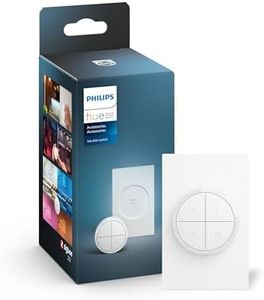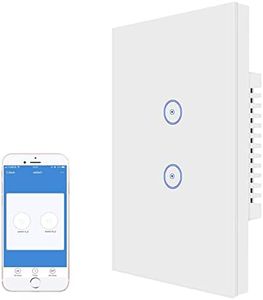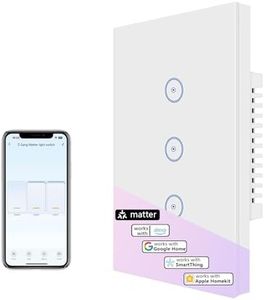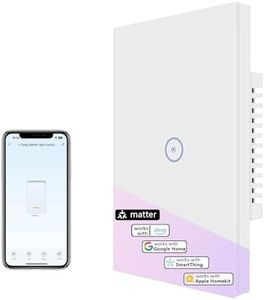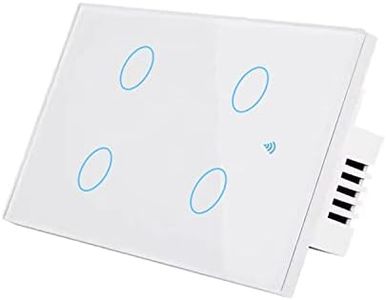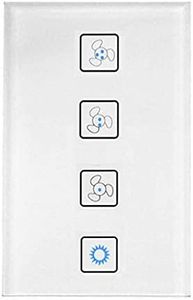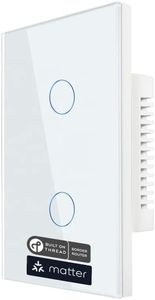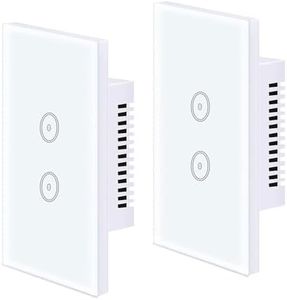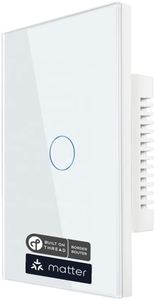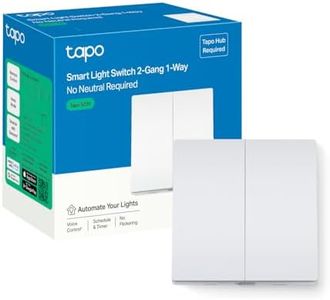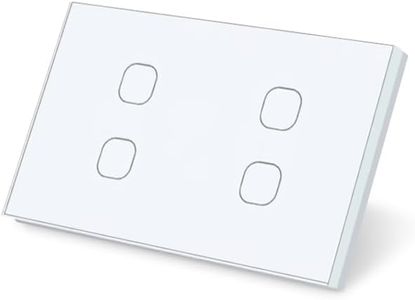We Use CookiesWe use cookies to enhance the security, performance,
functionality and for analytical and promotional activities. By continuing to browse this site you
are agreeing to our privacy policy
10 Best Smart Light Switches
From leading brands and best sellers available on the web.Buying Guide for the Best Smart Light Switches
Smart light switches can change the way you control lighting in your home, adding convenience and the ability to automate or remotely manage your lights. When you're choosing a smart light switch, it's important to think about how it will fit into your home’s existing wiring, the kind of control you want, and compatibility with other devices or systems you already own. Understanding the main features and specifications will help you find a model that’s perfect for your needs and daily habits.Switch Type (Single-Pole, 3-Way, etc.)This refers to how your switch connects to your home's wiring and how it controls the lights. A single-pole switch controls one light or group of lights from one spot, while a 3-way switch lets you control the same lights from two different locations, such as at both ends of a hallway. It's important to match the type to your existing wiring setup; if you are replacing a hallway switch controlled from two spots, you need a 3-way compatible smart switch, but for most regular lights, a single-pole will do. Check your setup before shopping—the right type ensures proper function and an easier installation.
Connectivity (Wi-Fi, Zigbee, Z-Wave, etc.)Connectivity means how your smart switch communicates with your phone or smart home system. Wi-Fi switches connect directly to your home network, making setup easy if you have a good signal where you install it. Zigbee and Z-Wave require an extra hub but can be more reliable if you have many smart devices. If this is your first smart product, Wi-Fi may be simplest. If you already have a hub like SmartThings or another smart home platform, consider matching the format for better integration. Pick a connection type that works smoothly with your other devices and offers reliable performance in your home.
Neutral Wire RequirementMany smart switches need a neutral wire to work because they require a small amount of constant power. Older homes sometimes don’t have a neutral wire in the switch box, which can make installation tricky or impossible without extra wiring. Check your switch box for a bundle of white wires (that’s probably the neutral). If you don’t have it, look for smart switches designed for no-neutral setups. Choosing a switch that fits your home’s wiring is crucial for safety and easy installation.
Voice Assistant SupportVoice assistant support means whether the smart switch can be controlled by smart speakers or displays like Alexa, Google Assistant, or Apple HomeKit. If you want to turn lights on and off by just speaking, make sure your switch works with your preferred platform. Consider your current or future plans for a smart home—matching compatibility with your gadgets means everything works together and you get full use of hands-free controls.
Dimming CapabilitySome smart switches not only turn lights on and off but also let you dim the lights for the perfect brightness. This is useful for creating mood lighting or saving energy. If you want this, check that both the switch and your light bulbs support dimming. If you only need basic on/off control, you can skip this extra feature. Think about the mood and flexibility you want in each room when deciding on a dimmer.
App Features and Remote ControlSmart light switches come with apps that let you control your lights from anywhere, set schedules, or automate routines. The differences can be in how easy the app is to use, whether you can group switches, and what kinds of timers or automations are available. If you travel a lot, remote access is very handy. If you like setting up different moods or scenes, look for rich app features. Make sure to consider your comfort with technology and how much customization you’ll actually use day-to-day.
Design and Button StyleThe style of a smart switch is about both looks and usability. Some have traditional rocker or toggle shapes, while others use touch panels or even touchless operation. Think about how it will blend with your wall plates and other switches, and whether the people in your home (especially kids or guests) will find it easy to use. Pick a design that fits your decorative style and feels comfortable for everyday use.

